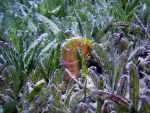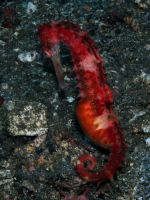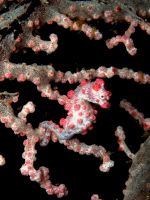Articles
Meeting with sea horses
11-9-2009
To meet kind of mysterious sea horse is a dream of many divers. Even though they are wide spread you don´t see them much. I have the luck to discover them many times during diving in Dahab bay (Egypt). Among isles of sand and grass from 1 to 15 metres depth I sometimes find these champions of camouflage. However not during whole year. I observed that they are here mostly during summer (july-september). I think that they are influences by temperature of water and length of daylight. Sea horses holds themselves to sea grass by tails, still and unnotocited they wait for food. They sway in rhythm of sea waves. First what catch your attention are big eyes, curiously watching world around them. But when I take my camera they turn their back againts me. This happened dozents of times like it would like to say : you can watch but please don´t make photos. I continue with discovering this amazing fragile creature and try to make a photo. It don´t work. Again and again it turns it´s back to my camera. I go from different directions and it still keep turning. After few circles around funny sea horse I don´t know how to catch it. I look at my buddy who evidently is greatly amused by mine trying. I choose new strategy with help of my buddy. Slowly and carefully I lie on the sand, take my camera and wait. My buddy is going near seahorse from opposite direction and the sea horse is now turning ahead to my camera. Click, click...and photo was made. I am happy like a sucesfull paparazzi. It was really hard...Sea horses belongs together with pipefishs to the family Sygnathidae, but they have alone subfamily Hippocampinae. There is about 50 species of sea horses all around the world. They differ in sizes and shapes (the smallest one is big as a nail of small finger). Some species are on the other hand more than 30 cm big. They are named horses beacuse of the shape of head which resambles head of normal horse. This unique fish doesn´t have pectoal fins, they move themselves by long spinal fin (more than 70 beats per secund). They move slowly but not too often. They mostly hold themselves by twisted tail near sea grass or various soft and hard corals. They mouth are toothless, they feed on small crustacea which are in water (like larvas of shrimps). When prey come near they suck it inside and swallow. They have no gunts, food is little digest and again let out to the water. Their body is made from bony desks (12 in ventral part, 32-35 on tail). The most mobile part of body is tail, which is used as a wheel while their are moving. They could get around not just in upright but even in upside down position. This is made by two chambers of air bladder. Sea horses are great champions in camouflages. Not even by color, but help to many different cirri they become invisible for their surroundings. They also can change their colour a little. You can find these fish all around the world. Most of them are in tropic and subtropic areas. Sea horses lives in pairs, their life is full of rituals and various dances. Every morning the couple greet themselves by a nice dance. During courtship and transporting of eggs to special bag on males belly (it is origin from conecting od ventral fins) they have complicated behaviour different for each species. Male and female connect together by tails mostly, they go up and down in water touching each other. This wedding dance could last more than 8 hours. After this female give her eggs to male sn he fertilize them. Male protect and carry them till the small horse are born. The babbies are about 10-12 mm big, about 150 pieces. After they are born male role of a parent finish. Sea horses are in danger not just by polluting of the sea, but lots of them are catched and given to aquariums. They are very sought after. In some areas people hunt them and dry them, they are used as aphrodisiakum.
back






